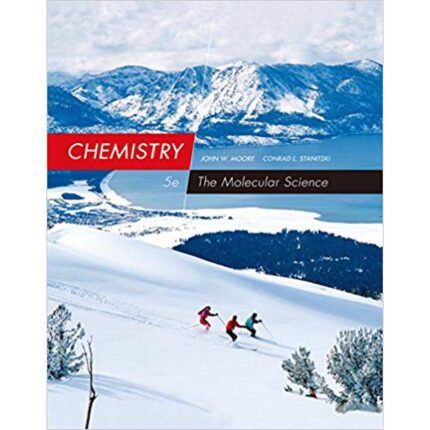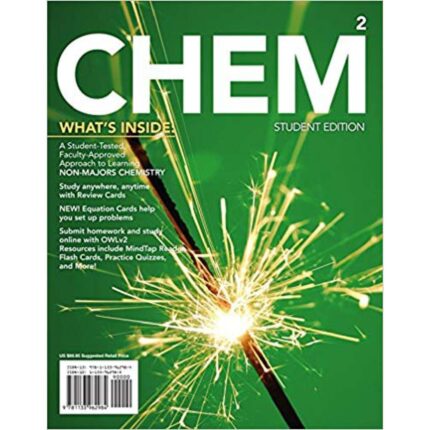MULTIPLE CHOICE
1. Which of the following correctly describes the states of matter and intermolecular forces?
1. The change in volume that accompanies the conversion of a liquid to a gas can be very large.
2. The change in volume that accompanies the conversion of a liquid to a solid is small.
3. The forces of attraction between molecules in the liquid and solid state correlate with melting point, boiling point, and the energy of phase changes.
a. 1 only b. 2 only c. 3 only d. 1 and 2 e. 1, 2 and 3
ANS: E
2. Which of the following correctly describes the influence of intermolecular forces on the properties of matter?
1. Intermolecular forces determine the solubility of gases, liquids, and solids in various solvents.
2. Intermolecular forces are directly related to the energy required to accomplish phase changes.
3. Intermolecular forces do not influence the structure of molecules like DNA and proteins.
a. 1 only b. 2 only c. 3 only d. 1 and 2 e. 1, 2 and 3
ANS: D
3. Which of the following statements concerning the attraction of ions to polar molecules is/are CORRECT?
1. The energy of attraction between an ion and a polar molecule is inversely proportional to the square of the distance between the center of the ion and the oppositely charged pole of the dipole.
2. The higher the ion charge, the stronger the attraction between the ion and a polar molecule.
3. The greater the magnitude of the dipole, the greater the attraction between the ion and a polar molecule.
a. 1 only b. 2 only c. 3 only d. 2 and 3 e. 1, 2, and 3
ANS: E
4. A molecule will always be polar if it ___.
a. has polar bonds
b. contains both carbon and chlorine
c. consists of more than three atoms
d. is diatomic with different electronegativities
e. contains atoms with different electronegativities
ANS: D
5. Which of the following statements best describes what happens when a small amount of solid rubidium bromide is dissolved in water?
a. The heat from the warm water melts the solid, making it a liquid.
b. Nothing happens, because rubidium bromide is insoluble in water.
c. The solid RbBr breaks apart into separate Rb and Br atoms by interacting with the water molecules.
d. The water molecules surround each ion in the solid RbBr, separating the Rb ions from the Br ions.
e. The solid undergoes a chemical change by reacting with the water.
ANS: D
6. Which one of the following statements is false?
a. All ions are hydrated in aqueous solution.
b. All cations are hydrated in aqueous solution.
c. All anions are hydrated in aqueous solution.
d. Hydration is generally highly endothermic for ionic compounds.
e. The heats of hydration of cations increases as their charge-to-radius ratios increase.
ANS: D
7. Place the following cations in order from the most negative to the least negative hydration enthalpy: Cs+, Na+, and Rb+.
a. Cs+ < Rb+ < Na+
b. Cs+ < Na+ < Rb+
c. Na+ < Rb+ < Cs+
d. Na+ < Cs+ < Rb+
e. Rb+ < Na+ < Cs+
ANS: C
8. Which of the following strong electrolytes has the least negative hydration enthalpy?
a. NaCl b. KCl c. RbCl d. CsCl e. HCl
ANS: D
9. Place the following cations in order from the lowest to the highest hydration enthalpy: K+, Ca2+, and Mg2+.
a. K+ < Ca2+ < Mg2+
b. Mg2+ < Ca2+ < K+
c. Ca2+ < K+ < Mg2+
d. Ca2+ < Mg2+ < K+
e. Mg2+ < K+ < Ca2+
ANS: A
10. Which one of the following sets of ions are listed in order of lowest to highest hydration energy?
a. H+ < Na+ < Mg2+
b. Mg2+ < Ca2+ < Ba2+
c. Mg2+ < Ba2+ < Ca2+
d. Ca2+ < K+ < Rb+
e. Rb+ < K+ < Ca2+
ANS: E
11. Which one of the following molecules will exhibit dipole-dipole intermolecular forces as a pure liquid or solid?
a. CS2 b. C2H2 c. CCl4 d. F2 e. PCl3
ANS: E
12. Which of the following bonds can potentially contribute to the formation of a hydrogen bond in a solid or liquid?
a. Ge—H b. P—H c. N—H d. Si—H e. Cl—H
ANS: C













Reviews
There are no reviews yet.